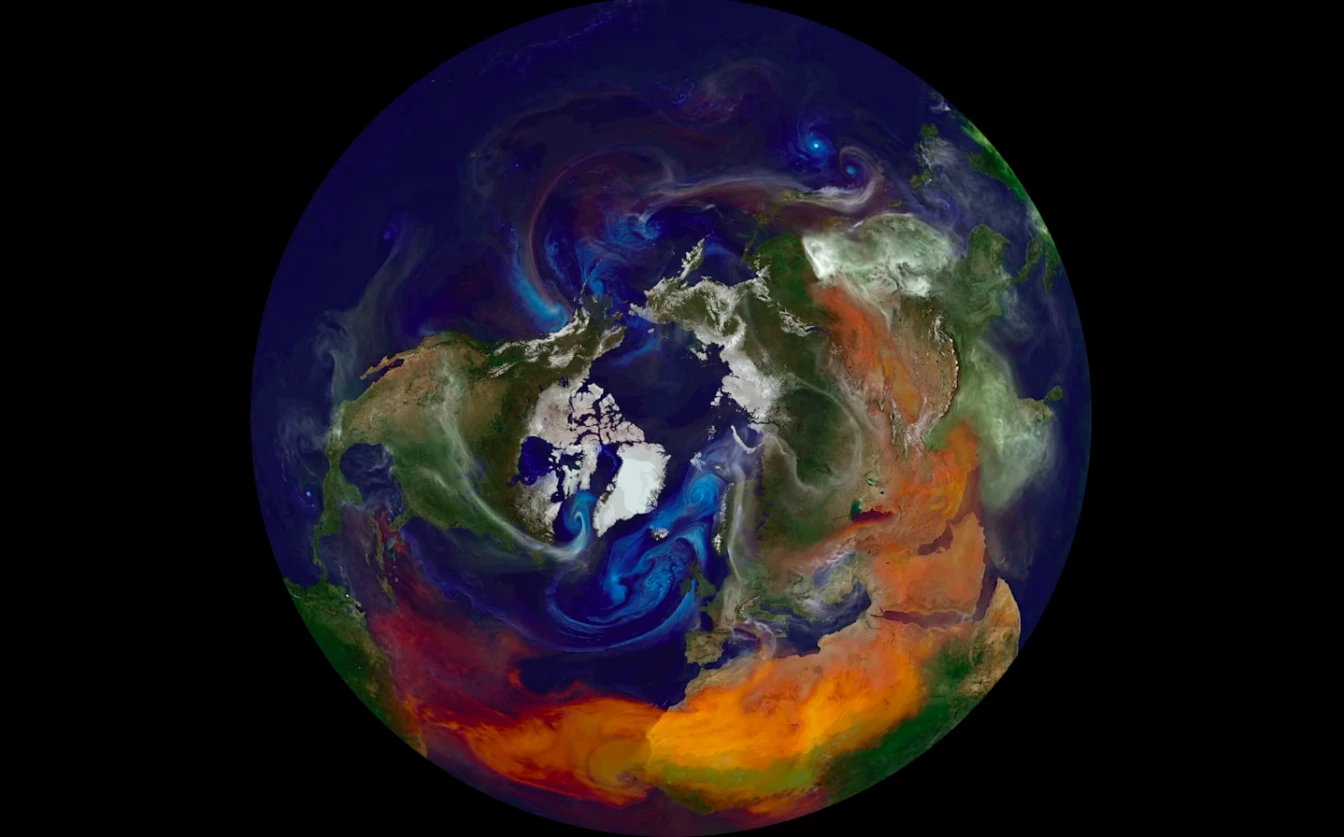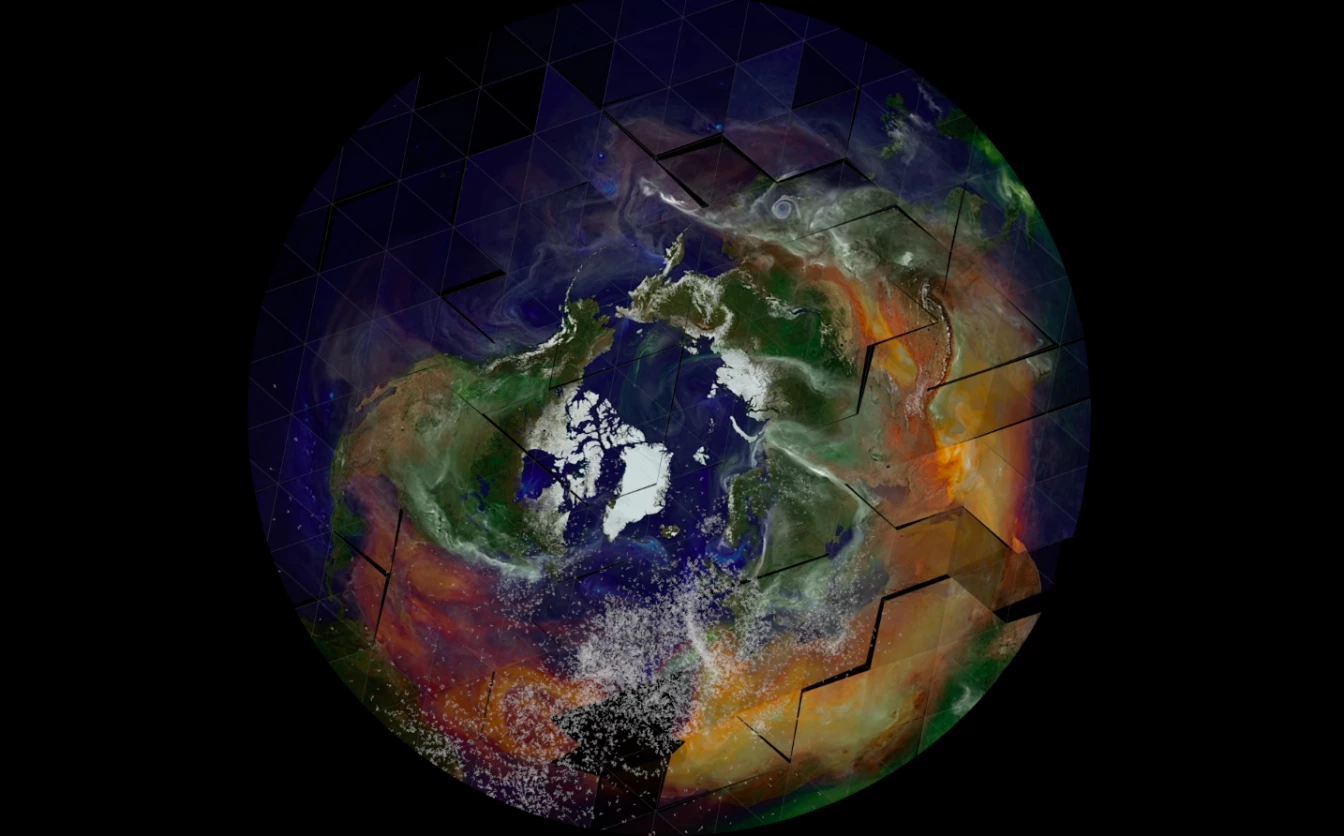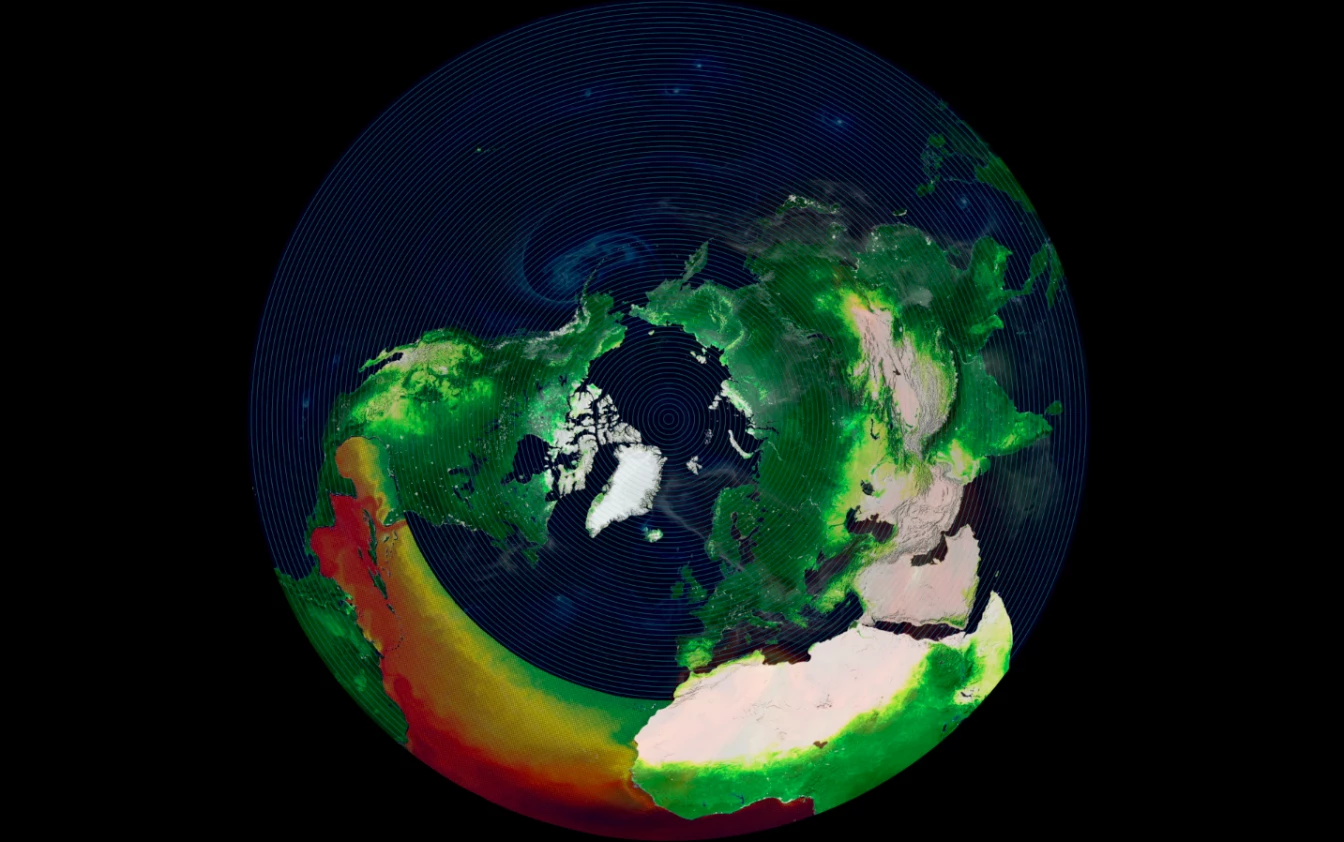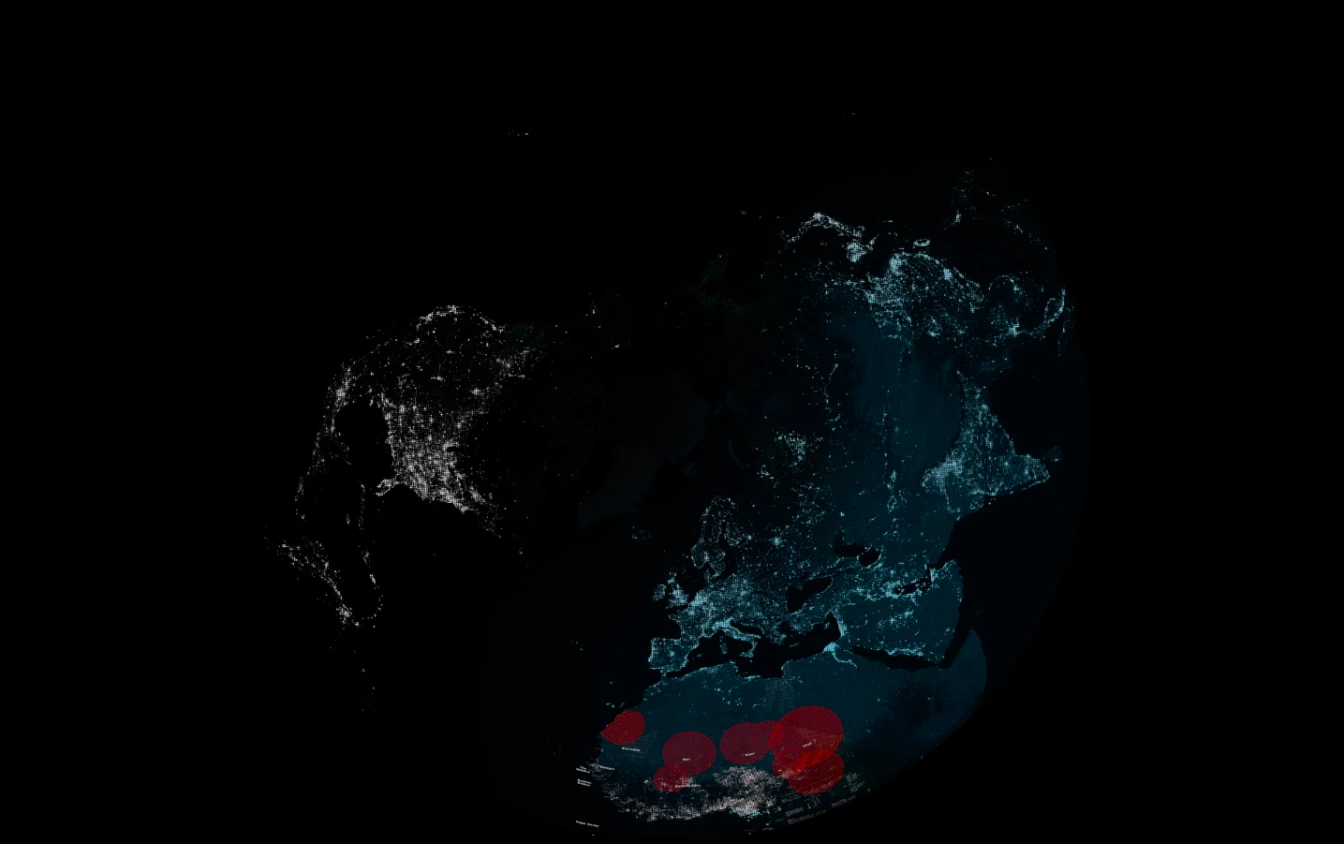The Mediterranean: A New Imaginary. Conflated Scales – Deep Inconsistencies

Adrian Lahoud, The Shape of the Eclipse, installation and projection, 2016. This project tracks the movement of anthropogenic aerosols from north to south, and the movement of humans from south to north. Emitted by industrial processes in the Northern Hemisphere and carried into the air by wind currents until they float high above the Atlantic Ocean, aerosols interact with solar radiation changing ocean temperatures and affecting the intensity of the wet season in the Sahel. One consequence of exacerbated water stress in the Sahel is a loss of arable land, something that intensifies existing conflicts and drives diasporic movements of people toward cities like Lagos and the shores of southern Europe.
Geological time and the chronology of human histories remained unrelated. This distance between the two calendars... has collapsed.1
The climate may well remain operative in writing Mediterranean history, but when that climate becomes man-made, what kinds of consequences does it hold for historical narration? The problem that organises today's Mediterranean is of a different order, an order of superimposition and conflation. It is a problem that binds together the consequences of Western industrialisation, global carbon emissions, aerosol dispersion patterns, sea surface temperatures, monsoons, precipitation, pastoralists, herders, farmers, cultivars, migratory routes, treaties, coast guards, statistical models, satellite imagery, and detention centres.
The idea of the anthropocene emerges as a proposal for a new geological periodisation by Paul Crutzen in a now well-known article in Nature published in 2002, where he proposed that with industrialisation and the liberation of intensive energy sources from fossil fuels a new geological epoch had been inaugurated.2 Humanity had begun to interact with and modify that aspect of the world once taken for an ambient backdrop: the climate. According to Crutzen, given humanity's new agency within a planetary-wide system of causes and effects, the climate – whether benign or malevolent – enters into the calculus of all those things that can be put at risk by human intervention.

Adrian Lahoud, The Shape of the Eclipse, installation and projection, 2016.
This era is already reorganising the Mediterranean; one thinks not only of recent European initiatives around sustainable energy in the North of Africa, such as the Desertec project, but also the forced displacements of people towards the magnetic attractor of the European coastline. This series of episodes chart the nascent formation of one of these problems: the nexus formed by climate, climate science, migration from the Sahel, and policing in the Mediterranean.
The World Dies from the North
The desertification of the Sahel has been accelerating since the 1970s, and increased population growth, which puts pressure on often unsuitable land, has put more bodies at risk. Combined with lower levels of precipitation, this has caused a drying of the Sahel, leading to prolonged water stress and reduced crop yields. Periods of extreme drought in the 1980s and 1990s placed further pressure on the precarious livelihoods of its inhabitants. As the Sahara continues its expansion down into previously fertile landscapes, the deadly march is perfectly captured by the Zaghawa people of Chad and Sudan who say that "the world dies from the north".3
The Anthropocenic Equator
Back then, the challenge was to stop a particular action. Now, the challenge is to inspire a particular action.4
As of January 2013, almost all eight situations before the International Criminal Court (ICC) involve African nations between the 20th northern and 10th southern parallel. Investigations in Uganda, Democratic Republic of Congo, Central African Republic, Darfur-Sudan, Kenya, Libya, Ivory Coast, and now Mali are confined to a narrow equatorial belt on a single continent, which U.S. security experts now refer to as a "corridor of terror". Hyperbole aside, this anthropocenic equator plays a critical geopolitical role in Africa's resource security and independence, which will depend on a more autonomous management of oil and gas reserves according to a nationalised model.

Adrian Lahoud, The Shape of the Eclipse, installation and projection, 2016.
Within the Western media, war crimes, crimes against humanity, and a legacy of camps, displaced persons, and famines reinforces the view of the Sahel as a space synonymous with violence and suffering. The perception of a landscape characterised by either warlords, jihadists, and child soldiers on one side, or drought-stricken adults and starving children on the other, leaves the Sahel in a bind, caught in a cliché of either hyper-aggressivity (genocide, terror, and massacre) or hyper-passivity (malnutrition and underdevelopment). While there is no doubt that serious issues are at stake and that many of them demand attention, it is no less important to note that the very constitution of the crisis state forms an integral element within the neo-colonial machinery and its management of foreign territories. The south is always posed as "not-yet" modern, "not-yet" complete project. It is framed in terms of its under development, described in terms of stagnations and pathologies which cannot but elicit sympathetic aid programmes and rescue packages from the ever vigilant North.5
The paternalistic Northern episteme has concrete material effects: for decades, it was assumed that desertification in the Sahel was primarily caused by poor farming practices – that local farmers could not adapt to changing environmental conditions as quickly as they needed to, leading to overgrazing, deforestation, and erosion. Similarly, military conflict was and still is too often seen as a simple by-product of ethnic and religious differences, the manifestation of ancient hatreds and tribal rivalries. More recently, however, another factor has come to play an increasing role in this complex matrix of alleged causes. In a 2007 Washington Post article, U.N. Secretary-General Ban Ki-moon proposed anthropogenic climate change as a contributor:
Two decades ago, the rains in southern Sudan began to fail. According to U.N. statistics, average precipitation has declined some 40 percent since the early 1980s. Scientists at first considered this to be an unfortunate quirk of nature. But subsequent investigation found that it coincided with a rise in temperatures of the Indian Ocean, disrupting seasonal monsoons. This suggests that the drying of sub-Saharan Africa derives, to some degree, from man-made global warming.6
The Sahel is marked by a high variability of annual precipitation and a long-term trend pointing to successively dryer conditions. Tensions between pastoralists and farmers over dwindling resources in conditions of desertification and water stress have brought different groups and their conflicting territorial practices into intimate proximity.
These differences are not essentialist traits; in fact, cultural markers such as Arab or African are fixed to livelihoods more than ethnicity. What is happening in Darfur then is a conflict between different ways of existing in the world as multiple spatial and cognitive practices superimpose on the same territory. In a condition of scarcity and within an ever-narrowing bandwidth of viability, the peoples of the Sahel are facing impossible pressures to coexist. In this context, the Mediterranean beckons as one horizon of escape.

Adrian Lahoud, The Shape of the Eclipse, installation and projection, 2016.
The Political Management of Movement
...the refugee throws into crisis the original fiction of sovereignty.7
Refugee movements intensify during periods of drought. In Africa, drought is thought to be partially responsible for the long-term pattern of urbanisation that the continent is experiencing. These movements and their environmental triggers are not exactly recent phenomena, however, nor does their renewed intensity signal a fall from some prior Edenic state of coexistence; the Sahel has always been characterised by migratory patterns that have followed resources and environmental transformation across longer and shorter terms.
Poor environments and social stress do not simply lead to migration, such that one term is always the precursor to the next. Disentangling the factors that lead to migration to adjudicate on migrant status, as either forced or displaced, is a fraught process. The veracity of testimony is one basis on which these claims will be assessed; more recently, however, in the case of dangers posed to larger populations by environmental destruction, mathematical and scientific modes of knowing have come to complement human ones. The mobilisation of science and especially advanced forms of statistical analysis occupy an increasingly prominent position within the biopolitical space of environmental violation. Though they do not touch the body directly, environmental violations affect the milieu that bodies depend upon for their survival. However, because chains of cause (violation) and effect (bodies) are diffused through atmospheres, landscapes, and seas, they depend on scientific forms of knowing such as simulation to make anomalies in environmental patterning visible; these anomalies can then help point to possible causes for the violation. Within international law, evidence in the form of human testimony followed on from the aftermath of World War II, building on definitions of genocide and crimes against humanity used in trials such as that of Adolf Eichmann.8 But what happens to the era of the witness when a crime is no longer visible to unmediated human perception? In the case of climate change, climate justice, and its future claimants around the shore of the Mediterranean, will the era of the model come to replace the era of testimony in adjudicating humanitarian claims?
Securing Freedom
Tomorrow Europe might no longer be Europe.9
The European agency Frontex now assumes responsibility for controlling the shared European border. Established in 2005 and working in cooperation with EU member states, it helps coordinate 500 million annual crossings at the 1,792 designated EU border crossing points. In their 2011 report Futures of Borders: A Forward Study of European Border Checks, the agency proposes a series of scenarios as a way of rehearsing possible border conditions and the responses they might demand.10 The "extreme wild card" scenario in the report describes a condition in which the Euro has collapsed, leading to the exit of member states, mass displacements of people due to climate change, and increased civil unrest in Sub-Saharan Africa, placing excessive pressure on EU border controls, which subsequently begin to collapse. The report concludes by proposing that preparations for emergency situations and mass influxes should begin in earnest, suggesting that the "Arab Spring" might have already made this wild card a reality by placing intense pressure on processing facilities such as those on the island of Lampedusa.
Today, the European border network extends not only through the Mediterranean and around the EU territory but also deep into North and Sub-Saharan Africa, where it is conceptualised through the idea of "pre-frontiering," a kind of pre-cognition of illegality materialised through treaties and cooperative security frameworks.11 This "forward defence system" means that the north-south imaginary of a border must be reconceptualised. It now exists as a network of policing, surveillance, and management extending across the surface of the Earth and sea, from the Arctic to the Equator, but also increasingly as a thick vertical depth, since it also includes electromagnetic detection systems and orbiting satellites. This infrastructure attempts to shift the burden of policing to non-EU states such as Libya, Algeria and Morocco in order to limit the legal obligations conferred to claimants within sovereign European territory.

Adrian Lahoud, The Shape of the Eclipse, installation and projection, 2016.
In 1999, at a summit for the Organization of African Unity, Colonel Qadhafi initiated a policy of unrestricted movement in Libya for anyone holding an African passport. Qadhafi's decision to reorient the nation's geopolitical attention to the south can be read in two ways, first as giving a renewed impetus to the promising idea of an African Union, or more cynically as a desire to access a cheap labour pool of southern workers. Moreover, by mid-2000 Libya, at both an informal and formal level, increasingly began to operate as a staging post for African migrants wishing to enter Europe. This situation reached a climax during the NATO-backed campaign against Qadhafi in February 2011, when he strategically played on European anxieties about the creation of a "black Europe" by deliberately intensifying Sub-Saharan migrant transit to Europe and effectively weaponising the traffic in refugees, leading to an undetermined number of deaths at sea.12
Desert Forensics
On an idealized view, high-quality scientific knowledge should and will automatically command policy choices, limiting disputes by partisans to issues of implementation.13
There is a growing attempt to pose the question of climate change at a scale that allows for a clearer picture of impacts on specific environments and the communities that make their livelihood from them. While climate modelling has long entered into the space of politics, it has done so primarily in terms of policy disputes, and global models of average temperature increase, since higher-resolution or fine-scaled models face both physical and computational challenges.14
Climate visualisations can now simulate the mixing of Sea Surface Temperatures (SST) in the Inter-tropical Convergence Zone (ITCZ), aerosol dispersion across the Mediterranean and Africa, and changes in carbon absorption in the Sahel. What these visualisations reveal, however, is more than kaleidoscopic gradients of colour; they expose the dynamic and differentiated form of climate impact, the dramatic reorganisation of resource availability, biological viability, and human fortune – in short, they reveal a new kind of geopolitical map.

Adrian Lahoud, The Shape of the Eclipse, installation at the Sursock Museum, Beirut, for the exhibition Let’s Talk about the Weather. Art and Ecology in a Times of Crisis, 2016. Photo by Nabû Productions.
As Thomas Keenan suggests in regard to humanitarian action and its tendency towards the mobilisation of shame, "No image speaks for itself, let alone... to our capacity for reason". If scientific images of climate change are to be used as the basis of political claims by groups currently marginalised from climate negotiations (like the G77 group of 120 developing nations), they will require translators, figures that can make the images speak – a qualification that might rest with all those subject to climate politics – or, today, in what amounts to the same thing, all those subject to the climate.15 This essay is a first gesture towards this kind of translation, constructing the kind of series that might be necessary to imagine a political sphere in which the animate and inanimate intermingle, and though it began with an account of drought in the Sahel in truth it has no origin, only a relay of forces that might be entered into at any point.
The ITCZ describes an area of fertile climatic instability where northeast and southeast trade winds interact, forming powerful convection currents in the atmosphere. The ITCZ plays an important role in regulating the intensity of the African monsoon, which depends on the powerful temperature and moisture gradients that form between the West African land mass and the Atlantic Ocean. The sensitivity of this relation and the key role played by SST has been the subject of a series of landmark papers published by Alesandra Giannini at The Earth Institute at Columbia University. This research reverses decades of orthodoxy that argued that local anthropogenic transformation (i.e., African agricultural practice) was responsible for desertification. The work concludes by proposing that persistent drought in the Sahel is not local in origin but rather the result of an increase in SST.
What is concealed behind the scientific expertise on climate and the effort to agree on the appropriate level of global temperature increase within forums like the COP (Conference of Parties) is the direct dependence of first-world GDP on carbon capacity. Within each degree of average increase, billions of dollars are congealed. In this regard, fossilised within every scientific model and dispute over average temperature increase is a nonscientific ethico-political paradigm. Inside every degree Celsius, a new calculus of life and death is disguised.
The Growth of Our Means Makes All Ends Equal
The civilian, too, is an invention of recent date.16
So too with the strange complications of the contemporary Mediterranean, a space that no longer fits into neat spatial or temporal scales, or legal jurisdictions, less still into clear bodies of knowledge. The possibility that the emission of aerosols in the Northern Hemisphere changes sea-surface temperature, weakening the African monsoon and drying the Sahel, is very likely but still under conjecture.17 That this drying exacerbates competition over resources, affecting communities undermined by poor government and abandoned by weak institutions, is not in doubt, nor is the chaos of violence and displacement that has ensued for more than three decades. As Sub-Saharan refugees enter the Mediterranean en route to Europe, they enter the most highly securitised waterway on Earth, moving from south to north across an Equator that divides those who are grievable from those who are not.18
Because the mechanics of climate form a complicated transport system, redistributing the effects of pollution according to a trans-boundary, nonlinear logic, the space of violation is separated from the space of its repercussion. Those least responsible for carbon emission will be most susceptible to drought and rising sea levels. Locard's principle that "every contact leaves a trace" – the cornerstone of modern forensics – still applies, but with one impossible catch: the contact and the trace drift apart, carried away on ocean currents and diffused into the atmosphere. The Earth's climate loosens the bond between cause and effect; it weakens the chain of custody and breaks the link between attribution, responsibility, and potentially, justice.
If the expansion of the Sahara follows aerosol dispersion in Europe and America, the world dies from the north twice over, once with particles migrating south through the atmosphere, a second time with people fleeing north towards the sea. Where is the familiar Mediterranean in all of this, and what does it matter?
The question that might be asked is what form of knowledge is required in a condition marked by scales that do not "properly" belong together? To start with, the idea of the city must be situated in a far wider epistemic frame. Beyond totalising notions of the global or the planetary, what is important on the contrary are the threads and traces that link disparate events around a problem. The question of scale then is something that should be understood as emerging from this network of linkages rather than something that pre-determines them.19 In the Mediterranean cities of today, it is less easy to find comfort in the charms of the vernacular, one finds instead the importation of Gulf development recipes to Algiers, the repeated evisceration of Lebanon's capital by petrodollars, a legacy of infrastructure around the Southern Italian coast abandoned by international labour markets. One also discovers European energy start-ups experimenting with solar plants in the Tunisian desert, heroin cartels managing international trade through ports in Marseille, black market economies of migrants on the streets of Athens salvaging steel that will be shipped around the world, in short any number of questions that might be dignified as "a project", that might orient our collective labour, attention and intellect. In each case however, design will have to learn again how to operate between the scale of the detail and the scale of the Earth.
A longer version of this essay appeared in The Mediterranean? New Geographies 5, edited by Antonio Petrov and published by Harvard University Graduate School of Design, Cambridge, Mass., 2013.